When the sun blazes and the temperatures soar, it might feel like keeping a lush, green lawn is just a dream slipping through your fingers. But guess what? The brutal sun doesn’t have to destroy your dream lawn. With the right strategies — and the right products — your yard can thrive even in the hottest conditions.
Maintaining a lawn in hot climates isn’t the same as caring for one in cooler, milder areas. High heat, dry soil, and intense sunlight put extra stress on your grass, making it thirstier and more nutrient-hungry than ever. Ordinary fertilizers often fall short during these harsh months, leading to burned patches, wasted water, and disappointment.
That’s why you need a specialized solution — and that’s exactly what this guide delivers. We’re diving deep into everything you need to know about choosing the best lawn fertilizer for hot area success. From understanding key nutrients to reviewing the top products, we’ve got your summer lawn care covered. Let’s get started!
How Hot Weather Affects Lawn Health
When summer rolls in with its scorching heat, your lawn faces a serious survival battle. The once vibrant, lush grass can quickly turn into a patchy, wilting mess if it’s not given the right care, and it’s not just about watering more often.
Heat stress is one of the biggest culprits behind a struggling lawn in hot climates. High temperatures cause grass blades to lose moisture faster than they can absorb it, leading to wilted, curled, or brown patches. Drought conditions only make matters worse by hardening the soil, limiting root growth, and preventing vital nutrient uptake.
On top of that, summer soil tends to lose nutrients rapidly. The intense heat speeds up microbial activity, depleting organic matter and breaking down fertilizers much faster than during cooler seasons. As a result, your grass doesn’t get the steady, long-lasting nutrition it needs to thrive.
Many homeowners reach for traditional fertilizers, hoping for a quick fix. Unfortunately, ordinary fertilizers often fail under these extreme conditions. Fast-release nitrogen blends can “burn” your lawn when temperatures are high, leaving you with yellowed or dead patches instead of the green oasis you envisioned.
That’s why selecting the best lawn fertilizer for hot area conditions is so critical. You need a product specially formulated to withstand the summer stressors — one that delivers slow, steady nutrients while strengthening your grass’s heat and drought defenses. Choose right, and your lawn can stay green, healthy, and absolutely stunning even when the sun is at its fiercest.
Key Nutrients to Look for in Fertilizer for Hot Climates
Choosing the best lawn fertilizer for hot area conditions isn’t just about grabbing the first bag you see on the shelf. It’s about understanding which nutrients your lawn desperately needs to survive — and thrive — under intense summer heat.
First up: Potassium (K). This powerhouse nutrient is crucial for boosting your lawn’s drought resistance, heat tolerance, and overall hardiness. A fertilizer with a high potassium content helps strengthen grass roots and improve water retention, keeping your lawn greener, longer.
Next, look for Slow-Release Nitrogen (N). While nitrogen is vital for lush, leafy growth, too much fast-release nitrogen during hot spells can actually scorch your grass. A slow-release formula delivers steady nutrition over time, reducing the risk of burning while promoting a healthy, vibrant color.
Phosphorus (P), often included to support root development, should be used carefully. In hot climates, unless a soil test shows a deficiency, it’s better to opt for fertilizers with low or zero phosphorus. Many states even regulate phosphorus use to protect waterways, so always check your local guidelines.
Finally, don’t overlook Micronutrients like iron, sulfur, and magnesium. These trace elements can make a noticeable difference by enhancing your lawn’s resilience against heat stress and boosting that deep, rich green color you’re aiming for.
Bottom line? Picking a fertilizer rich in these essentials is key to getting the results you want. Every product we recommend later on meets these critical standards for the best lawn fertilizer for hot area lawns.
Top 5 Best Lawn Fertilizers for Hot Areas
Not every fertilizer is built to withstand the intense heat and drought of summer. That’s why choosing the best lawn fertilizer for a hot area is crucial — you need products that nourish without burning, strengthen roots, and support lush, vibrant growth.
Here’s a deep dive into five top-rated options that can handle the heat!
1. Milorganite 0636 Organic Nitrogen Fertilizer
Milorganite 0636 Organic Nitrogen Fertilizer is a widely recognized, eco-friendly, slow-release fertilizer suitable for lawns, gardens, trees, shrubs, and vegetables. Produced from heat-dried biosolids by the Milwaukee Metropolitan Sewerage District, it’s a product of one of the oldest recycling initiatives in the U.S., transforming wastewater into valuable nutrients for plants.
Key Features
- Nutrient Composition (N-P-K): 6-4-0
- Nitrogen (N): 6.0% total, with 3.5% water-insoluble (slow-release) and 2.5% water-soluble
- Phosphorus (P): 4.0%
- Iron (Fe): 2.5%
- Calcium (Ca): 1.2%
- Chlorine (Cl): Maximum 1.0%
- Contains no potassium (K)
- Coverage: One 32 lb (14.5 kg) bag covers up to 2,500 sq ft (232 m²)
- Feeding Duration: Provides nutrients for 8–10 weeks
- Application Rate: 32 lbs per 2,500 sq ft for established lawns; 64 lbs per 2,500 sq ft for new lawns
- Safety: Non-burning, safe for use around children and pets, and doesn’t require watering in after application
Pros:
✅ Minimal risk of burning, even in peak heat.
✅ Safe for kids and pets.
✅ Boosts soil microbial activity.
Cons:
❌ Lower immediate green-up compared to chemical fertilizers.
❌ Slight earthy odor after application.
Best For:
- Homeowners who prefer organic options.
- Warm-season grasses like Bermuda and St. Augustine.
Milorganite is a true classic when it comes to finding the best lawn fertilizer for hot area lawns, offering safe, consistent performance even during the hottest months.
2. Scotts Turf Builder SummerGuard Lawn Food
Scotts® Turf Builder® SummerGuard® Lawn Food with Insect Control is a dual-action lawn care product designed to nourish your grass while protecting it from common summer pests.
Key Features
- Nutrient Composition (N-P-K): 20-0-8
- Nitrogen (N): 20%
- Phosphorus (P): 0%
- Potassium (K): 8%
- Insect Control: Contains 0.086% Bifenthrin, effectively targeting surface-dwelling pests such as ants, armyworms, chinch bugs, crickets, fleas, grasshoppers, spiders, and ticks.
- Application Timing: Ideal for use during the summer months (June to August) when lawns are susceptible to heat, drought, and insect activity.
- Coverage Options:
- 13.35 lb bag covers up to 5,000 sq. ft.
- 40.05 lb bag covers up to 15,000 sq. ft.
- Grass Compatibility: Safe for use on all grass types.
Pros:
✅ Dual-action formula: feeds and protects.
✅ Fast visible results.
✅ Easy to apply with any broadcast spreader.
Cons:
❌ May need frequent reapplication.
❌ High nitrogen could stress sensitive grasses if overapplied.
Best For:
- Lawns are struggling with pests and heat damage.
- Active families need quick lawn revival for summer activities.
If you want a fast-acting solution, Scotts SummerGuard easily ranks among the best lawn fertilizers for hot area conditions.
3. Jonathan Green Summer Survival Fertilizer
Jonathan Green Summer Survival Insect Control with Lawn Fertilizer is a dual-action product designed to nourish your lawn during the summer months while effectively controlling surface-feeding insects.
Key Features
Nutrient Composition (N-P-K): 13-0-3
- Nitrogen (N): 13% total, with 5.2% slowly available nitrogen from polymer-coated sulfur-coated urea
- Phosphorus (P): 0%
- Potassium (K): 3%
Insect Control: Targets over 15 surface-feeding insects, including chinch bugs, billbugs, ticks, fleas, armyworms, ants, sod webworms, and centipedes
Coverage Options:
- 15 lb bag: covers up to 5,000 sq. ft.
- 45 lb bag: covers up to 15,000 sq. ft.
Application Timing: Ideal for use in spring, summer, or early fall when insects first appear
Grass Compatibility: Safe for use on all grass types
Pros:
✅ Enhances root strength and water retention.
✅ Low burn risk during peak heat.
✅ Helps lawns recover from drought damage.
Cons:
❌ Not a major quick green-up product.
❌ Premium price point.
Best For:
- Lawns under severe heat and drought stress.
- Grass types like Zoysia and Bermuda need strong root systems.
For those living in brutally hot areas, this is easily one of the best lawn fertilizers for hot areas choices for deep, resilient growth.
4. Safer Brand Ringer Lawn Restore Fertilizer
Safer® Brand Ringer® Lawn Restore® Fertilizer is an organic, non-burning lawn fertilizer designed to revitalize your lawn by promoting healthy growth and strong root systems.
Key Features:
Nutrient Composition (N-P-K): 9-0-2
- Nitrogen (N): 9% (with 95% as slow-release water-insoluble nitrogen)
- Phosphorus (P): 0%
- Potassium (K): 2%
Formulation: Made from naturally derived protein sources like feather meal and blood meal, this fertilizer contains no manure, ensuring an odor-free application.
Coverage: A 20 lb bag covers up to 5,000 sq ft.
Application Timing: Suitable for application in spring, summer, and fall.
Grass Compatibility: Safe for use on all grass types.
Pros:
✅ No harsh chemical smells.
✅ Gradual, natural green-up without shocking the lawn.
✅ Eco-friendly and great for organic lawns.
Cons:
❌ Slower visible results compared to chemical options.
❌ Needs consistent watering for best effect.
Best For:
- Families with pets and kids.
- Homeowners are committed to organic lawn care practices.
If you’re aiming for an organic, stress-free solution, Safer Brand Ringer could be your ideal pick among the best lawn fertilizers for hot areas options.
5. Anderson’s PGF Complete 16-4-8 Fertilizer
The Andersons PGF Complete 16-4-8 Fertilizer is a professional-grade, all-in-one lawn fertilizer designed to deliver both immediate and long-lasting nutrition. It’s suitable for various grass types and is formulated to promote a lush, green lawn.
Key Features:
Key Features
- Nutrient Composition (N-P-K): 16-4-8
- Nitrogen (N): 16%
- Phosphorus (P): 4%
- Potassium (K): 8%
- Additional Nutrients:
- Iron: 3%
- Micronutrients: Included
- Humic DG: 7%
- Particle Size: Super-fine particles ensure even distribution, providing twice the number of particles per square foot compared to standard fertilizers
- Release Mechanism: Combines quick-release and slow-release nitrogen, offering immediate feeding and sustained nutrition for up to 8 weeks.
- Application Timing: Suitable for use in spring, summer, and fall. Apply every 6–8 weeks during the growing season.
- Grass Compatibility: Safe for all grass types, including cool-season (e.g., fescue, bluegrass) and warm-season (e.g., Bermuda, zoysia) grasses.
Pros:
✅ Provides balanced feeding across nitrogen, phosphorus, and potassium.
✅ Quick and consistent results.
✅ Works with both cool- and warm-season grasses.
Cons:
❌ Not fully organic.
❌ Requires careful spreader calibration.
Best For:
- Homeowners want even feeding and lush growth.
- Lawns that need a little bit of everything: strength, color, and resilience.
Anderson’s PGF is a solid all-around performer, making it a smart choice when shopping for the best lawn fertilizer for hot area lawns needing a full nutrient boost.
How to Properly Apply Lawn Fertilizer in Hot Weather
Using the best lawn fertilizer for hot area lawns is just half the battle — applying it the right way is what truly makes the difference between a thriving lawn and a burned-out one.
Here’s how to make sure your hard work pays off:
Best Time of Day to Apply
Always apply fertilizer during the early morning or late evening hours when temperatures are cooler and the sun isn’t beating down. Midday applications can literally cook your grass and waste your fertilizer by evaporating its moisture content before it even reaches the roots.
Watering Tips: Pre-Watering vs. Post-Fertilizer Irrigation
- Pre-Watering: Lightly water your lawn a day before applying fertilizer to soften the soil. This helps nutrients penetrate deeper.
- Post-Fertilizer Irrigation: After applying, always water the lawn thoroughly unless the product says otherwise. Watering activates the fertilizer and reduces the risk of burning the grass.
Proper Spreading and Calibration
Incorrect spreader settings are one of the most common fertilization mistakes. Always calibrate your spreader according to the product instructions to avoid over-fertilization, which can lead to “fertilizer burn” and damage patches that are hard to repair.
Mistakes to Avoid
- Never fertilize during peak heat (midday to early afternoon).
- Avoid using fast-release nitrogen products in extreme heat unless absolutely necessary — slow-release formulas are your lawn’s best friend during summer.
By following these smart application techniques, your investment in the best lawn fertilizer for hot area products will give you the thick, vibrant, summer-proof lawn you’ve been dreaming of.
Best Grass Types for Hot Areas and How Fertilizer Helps Them
Choosing the right grass type is just as important as picking the best lawn fertilizer for hot area success. Some grasses are naturally better equipped to handle heat, drought, and tough soil conditions — and when paired with the right fertilizer, they truly shine.
Bermuda Grass
Bermuda grass is a top performer in hot climates thanks to its deep root system and rapid growth. It loves full sun but can go dormant in extreme drought without proper care.
Fertilizer Tip: Bermuda thrives with a nitrogen-rich fertilizer that has slow-release properties. High potassium content also helps it resist drought stress.
Zoysia Grass
Zoysia grass forms a dense, carpet-like lawn that can withstand both heat and moderate foot traffic. It’s slightly more shade-tolerant than Bermuda but still loves warmth.
Fertilizer Tip: A balanced fertilizer with moderate nitrogen and high potassium keeps Zoysia healthy without excessive growth spurts that require constant mowing.
St. Augustine Grass
Known for its broad blades and lush appearance, St. Augustine grass is a heat-lover that handles salty soils well, making it perfect for coastal hot areas.
Fertilizer Tip: Use a slow-release fertilizer that’s gentle on roots. St. Augustine responds well to formulas rich in potassium and micronutrients like iron.
Centipede Grass
Centipede grass is low-maintenance, heat-tolerant, and thrives on “less is more” fertilization. It’s an ideal choice for homeowners who prefer a laid-back lawn care routine.
Fertilizer Tip: Choose a fertilizer with lower nitrogen levels and a good potassium boost. Over-fertilizing can actually harm Centipede lawns.
No matter which warm-season grass you choose, pairing it with the best lawn fertilizer for hot area conditions ensures greener, stronger, and more resilient results — even during the toughest summer months!
❓ FAQs About Lawn Fertilization in Hot Areas
1. Can I fertilize my lawn during a heatwave?
Technically, yes — but it’s not ideal. Fertilizing during a heatwave can put extra stress on your grass, especially if you use a fast-release fertilizer. If you must fertilize, choose a slow-release product and apply it early in the morning or late in the evening, followed by deep watering. This reduces the risk of fertilizer burn and helps your lawn absorb nutrients safely.
2. How often should I fertilize my lawn in hot climates?
In hot areas, lawns generally benefit from lighter, more frequent feedings rather than heavy, infrequent applications. A good rule of thumb is every 6–8 weeks during the active growing season. Always follow the specific instructions on your chosen fertilizer label to avoid overdoing it.
3. Should I mow before or after fertilizing in hot weather?
It’s best to mow before you fertilize! Cutting your grass to the recommended height ensures that fertilizer granules can reach the soil surface easily and won’t just stick to the tall blades. After fertilizing, water the lawn thoroughly to help nutrients soak into the roots.
4. Is organic fertilizer better for hot areas?
Organic fertilizers can be an excellent choice for hot climates because they release nutrients slowly and improve soil structure over time. They’re less likely to cause burning compared to synthetic fertilizers. If you want a safer, soil-friendly option during the summer, an organic product might be your pick for the best lawn fertilizer for hot area care.
5. Can over-fertilizing kill my lawn in summer?
Absolutely. Over-fertilizing is one of the fastest ways to damage or kill your lawn, especially in extreme heat. Too much nitrogen can “burn” your grass, leaving it yellow, brown, or even dead in patches. Always measure carefully, use slow-release options when possible, and avoid fertilizing during the hottest part of the day.
Final Verdict
Surviving — and thriving — through a hot summer starts with giving your lawn exactly what it needs. Selecting the best lawn fertilizer for hot area success means focusing on slow-release nitrogen, high potassium content, and careful application practices to beat the heat.
Remember, it’s not just about choosing the right product — it’s about applying it smartly, watering wisely, and giving your grass the steady, stress-free feeding it craves during extreme temperatures. When you match the right fertilizer to your specific grass type and climate needs, a healthy, green lawn isn’t just a wish — it’s your reality.
Even in scorching heat, your dream of a vibrant, lush lawn is possible.
You just need the right tools and a little strategy to make it happen.







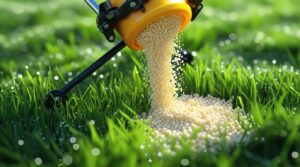
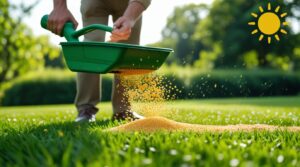
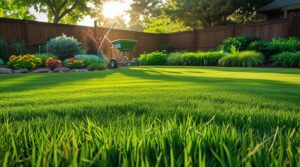
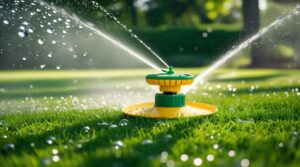
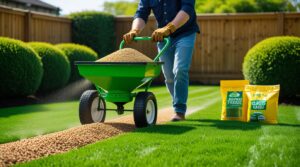
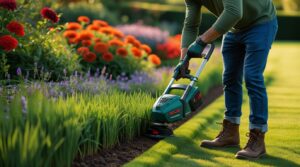
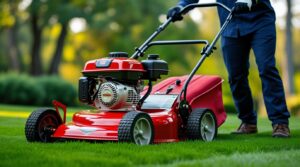
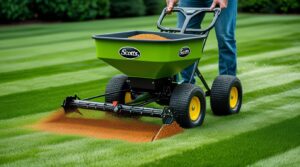
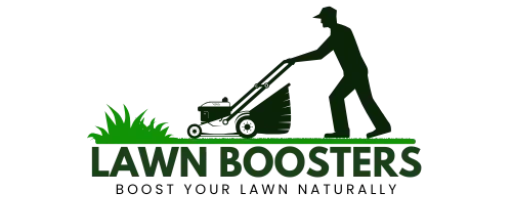
1 Comment
Your comment is awaiting moderation.
I’m not sure why but this blog is loading incredibly slow for me.
Is anyone else having this problem or is it a problem on my end?
I’ll check back later on and see if the problem still exists.
er